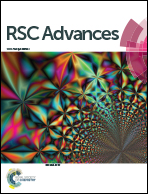Impact of structural stability of cold adapted Candida antarctica lipase B (CaLB): in relation to pH, chemical and thermal denaturation†
Abstract
The effect of pH on the conformational behavior of Candida antartica lipase B (CaLB) has been monitored by spectroscopic and calorimetric studies. The results obtained from far and near-UV CD, intrinsic fluorescence and ANS binding studies indicate that CaLB exhibits the characteristic properties of a molten globule in acidic (protonated) conditions at pH 1.4. The molten globule state retained about 67% of its secondary structure with a substantial loss of tertiary structure at pH 1.4. Moreover, equilibrium unfolding studies indicated that the ‘molten-globule-like’ state unfolds in a non-cooperative manner and is thermodynamically less stable than that of the native state. The molten globule possessed a slightly higher Rh than its native state. The DSC thermogram shows a high heat signal at pH 7.4, and a low heat signal at pH 2.6, and suggests that CaLB is likely to have undergone structural changes during the thermal unfolding. However partially unfolded CaLB at pH 1.4 does not produce a DSC peak which proves the existence of the molten globule state at pH 1.4 as supported by spectroscopic data. The Stokes radius of the MG state obtained by SEC experiments is found to be 33% larger than the native state, but essentially smaller than the denatured state.


 Please wait while we load your content...
Please wait while we load your content...